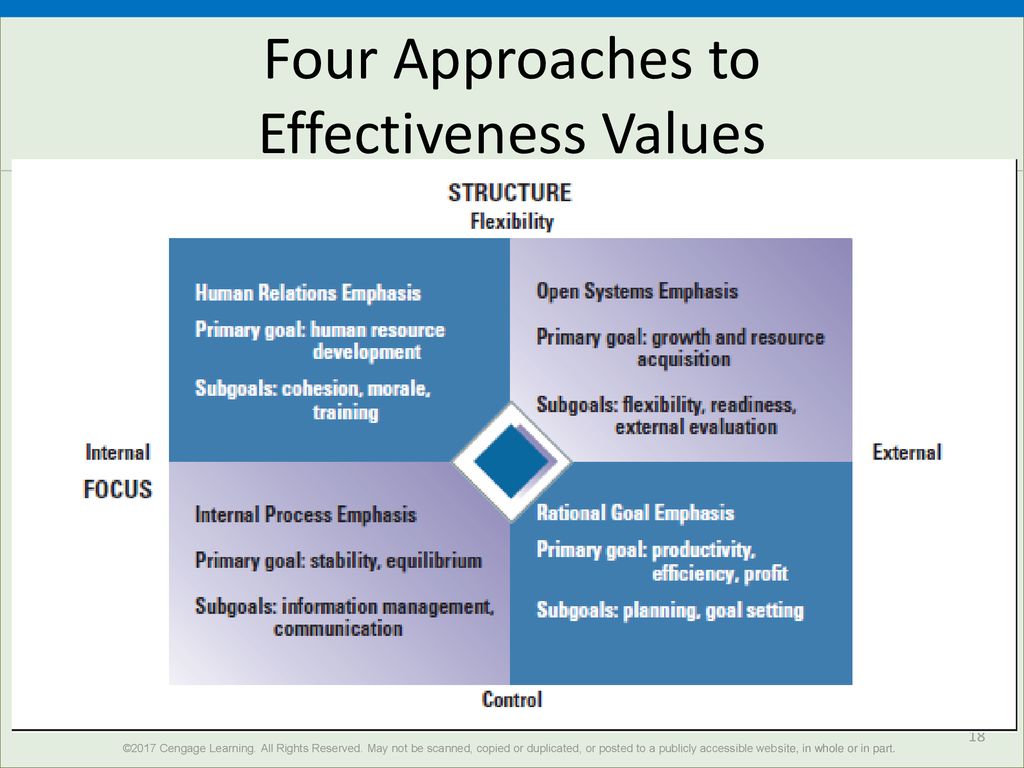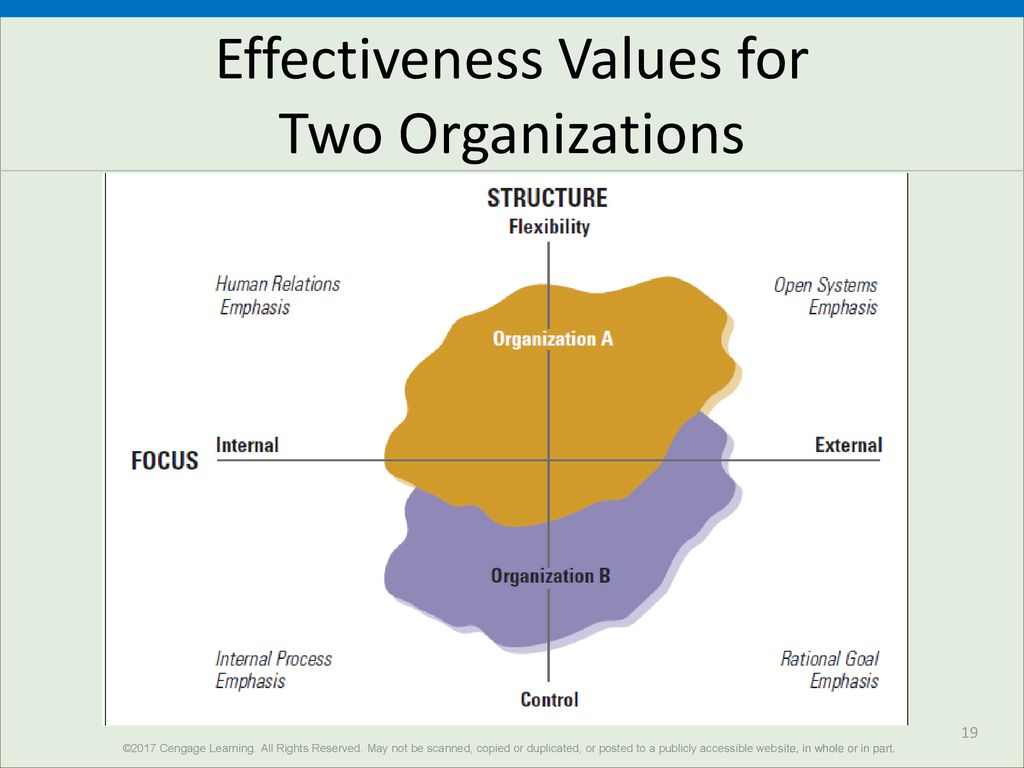An Integrated Effectiveness Model
The Competing Values Model
The competing values model tries to balance a concern with various parts of the organization rather than focusing on one part.
This approach to effectiveness acknowledges that organizations do many things and have many outcomes. It combines several indictors of effectiveness into a single framework.
The model is based on the assumption that there are disagreements and competing viewpoints about what constitutes effectiveness. Managers sometimes disagree over which are the most important goals to pursue and measure.
One tragic example of conflicting viewpoints and competing interests comes from NASA.
After seven astronauts died in the explosion of the space shuttle ColumbiaOpens in new window in February 2003, an investigative committee found deep organizational flaws at NASAOpens in new window, including ineffective mechanisms for incorporating dissenting opinions between scheduling managers and safety managers.
External pressures to launch on time overrode safety concerns with the Columbia launch. Similarly, Congressional investigations of the 2010 Deepwater Horizon oil rig explosion and oil spillOpens in new window in the Gulf of Mexico found the BP engineers and managersOpens in new window made a number of decisions that were counter to the advice of key contractors, putting goals of cost control and timeliness ahead of concerns over well safety.
BP and NASA represent how complex organizations can be, operating not only with different viewpoints internally but also from contractors, government regulators, Congress, and the expectations of the American public.
The competing values model takes into account these complexities. The model was originally developed by Robert Quinn and John Rohrbaugh to combine the diverse indicators of performance by managers and researchers.
Using a comprehensive list of performance indicators, a panel of experts in organizational effectiveness rated the indicators for similarity. Their analysis found underlying dimensions of effectiveness criteria that represented competing management values in organizations.
Indicators
The first value dimension pertains to organizational focus, which is whether dominant values concern issues that are internal or external to the firm.
- Internal focus reflects a management concern for the wellbeing and efficiency of employees, and
- external focus represents an emphasis on the wellbeing of the organization itself with respect to the environment.
The second value dimension pertains to organizational structureOpens in new window and whether stability or flexibility is the dominant structural consideration.
Stability reflects a management value for efficiency and top-down control, whereas flexibility represents a value for learning and change.
The value dimensions of structure and focus are illustrated in Figure X-1.
 Figure X-1 Four Approaches to Effectiveness Values | Credit — Slide Player Opens in new window
Figure X-1 Four Approaches to Effectiveness Values | Credit — Slide Player Opens in new window
The combination of dimensions provides four approaches to organizational effectiveness, which, though seemingly different, are closely related. In real organizations, these competing values can and often do exist together. Each approach reflects a different management emphasis with respect to structure and focus.
- Open System Emphasis
A combination of external focus and flexible structure leads to an open systems emphasis. Management’s primary goals are growth and resource acquisition.
The organization accomplishes these goals through the subgoals of flexibility, readiness, and a positive external evaluation. The dominant value is establishing a good relationship with the environment to acquire resources and grow. This emphasis is similar in some ways to the resource-based approachOpens in new window.
- Rational Goal Emphasis
The rational goal emphasis represents management values of structural control and external focus. The primary goals are productivity, efficiency, and profit. The organizational outcomes are internal planning and goal setting, which are rational management tools. The rational goal emphasis is similar to the goal approach described earlier.
- Internal Process Emphasis
The internal process emphasis is in the lower-left section of Figure X-1; it reflects the values of internal focus and structural control. The primary outcome is a stable organizational setting that maintains itself in an orderly way.
Organizations that are well established in the environment and simply wants to maintain their current position would reflect this emphasis. Subgoals include mechanisms for efficient communication, information management, and decision making.
Although this part of the competing values model is similar in some ways to the internal process approach described earlier, it is less concerned with human resources than with other internal processes that lead to efficiency.
- Human Relations Emphasis
The human relations emphasis incorporates the values of an internal focus and a flexible structure. Here, management concern is for the development of human resources. Employees are given opportunities for autonomy and development.
Management works toward the subgoals of cohesion, morale, and training opportunities. Organizations adopting this emphasis are more concerned with employees than with the environment.
The four cells in Figure X-1 represent opposing organizational values. Managers decide which values will take priority in the organization. For example, managers at Stryker CorporationOpens in new window, which makes surgical equipment and implants used in joint replacements, among other medical devices, emphasize values of openness and flexibility to keep people throughout the company innovating on a day-to-day basis.
Yet the organization also has values of control and efficiency. StrykerOpens in new window keeps research and development costs relatively low compared to other device makers. The way two organizations are mapped onto the four approaches is shown in Figure X-2.
 Figure X-2 Effectiveness Values for Two Organizations | Credit — Slide Player Opens in new window
Figure X-2 Effectiveness Values for Two Organizations | Credit — Slide Player Opens in new window
Organization A is a young organization concerned with finding a niche and becoming established in the external environment. Primary emphasis is given to flexibility, innovation, the acquisition of resources from the environment, and the satisfaction of external strategic constituents.
This organization gives moderate emphasis to human relations and even less emphasis to current productivity and profits. Satisfying and adapting to the environment are more important. The attention given to open systems values means that the internal process emphasis is practically nonexistent. Stability and equilibrium are of little concern.
Organization B, in contrast, is an established business in which the dominant value is productivity and profits. This organization is characterized by planning and goal setting.
Organization B is a large company that is well established in the environment and is primarily concerned with successful production and profits. Flexibility and human resources are not major concerns. This organization prefers stability and equilibrium to learning and innovation because it wants to maximize the value of its established customers.
Usefulness
The competing values model makes two contributions.
- First, it integrated diverse concepts of effectiveness into a single perspective. It incorporates the ideas of output goals, resource acquisition, and human resources development as goals the organization tries to accomplish.
- Second, the model calls attention to how effectiveness criteria are socially constructed from management values and shows how opposing values exist at the same time.
Managers must decide which values they wish to pursue and which values will receive less emphasis. The four competing values exist simultaneously, but not all will receive equal priority.
For example, a new, small organization that concentrates on establishing itself within a competitive environment will give less emphasis to developing employees than to the external environment.
The dominant values in an organization often change over time as organizations experience new environmental demands, new top leadership, or other changes. For example, when Samsung GroupOpens in new window managers shifted the company’s focus from quantity of sales to quality of products, it required a shift in dominant values.
| Samsung Group as Practical Example |
|---|
| Samsung once pursued sales of quantity-driven, low-end products as a primary goal. Managers emphasized stability, productivity, and efficiency. That all changed when Samsung Group chairman Kun-hee Lee visited a Los Angeles retailer in the early 1990s and found boxes of Samsung products gathering dust on back shelves while customers admired the cutting-edge products from other manufacturers. Lee returned to Korea, ordered $50 million worth of inventory destroyed, and declared that quality and innovation would be the new guiding principles. The new approach, which emphasizes employee empowerment and training, creativity, flexibility, and innovative responses to the external environment, has been highly successful. Today, Samsung is ranked among the world’s most valuable brands and its smartphones challenge Apple’s iPhone for style and innovativeness. When Samsung flipped its focus from quantity to quality, it needed a new emphasis on people. “People Come First” and “A Company Is Its People” are mottos that guide the company, and talent management is emphasized to prepare a pool of next-generation leaders. New digital learning facilities and networking spaces have been created to foster creativity and innovation |
The effectiveness values that guided SamsungOpens in new window in the past reflected a primarily internal process and rational goal emphasis. Managers valued stability, productivity, efficiency, and steady profits. However, Chairman Kun-hee Lee saw that profitability would not continue for long unless things changed. He shifted the organization to effectiveness values that reflect a primarily human resource and open systems emphasis.
Remember, all organizations are a mix of competing ideas, goals, and values. Goal emphasis and values change over time to meet new needs.
The Series:
- Research data for this work have been adapted from the manual:
- Organization Theory & Design By Richard L. Daft

